This Italian Foodie Spot Is Music to a Tourist’s Ears
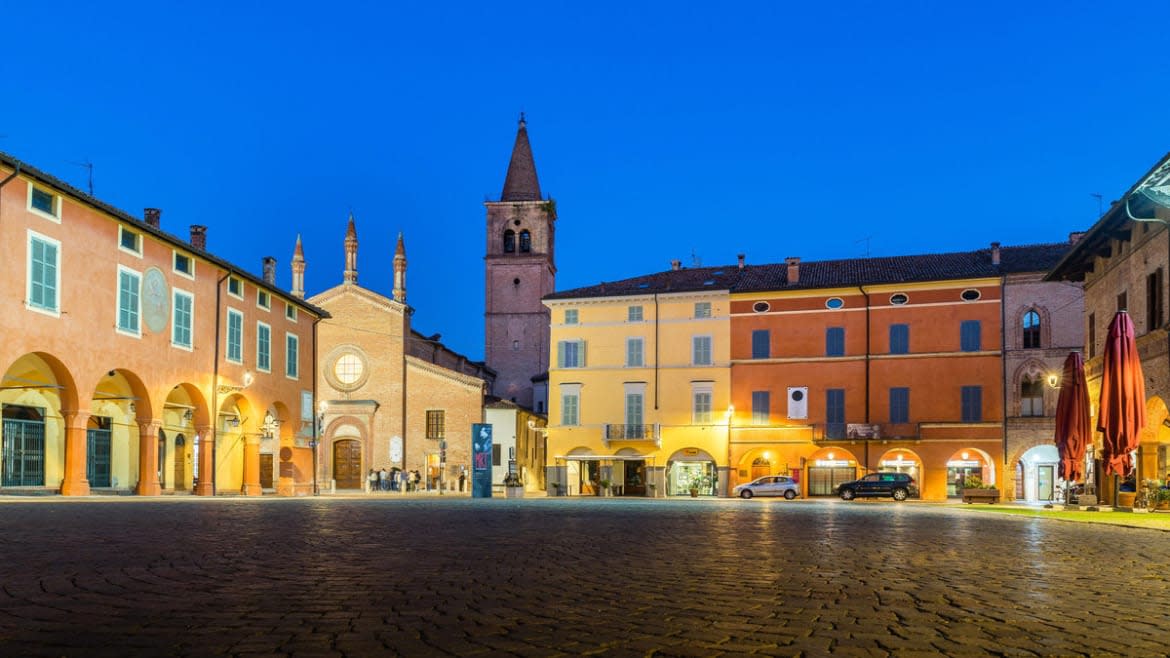
- Oops!Something went wrong.Please try again later.
Barreling down an Italian country road in a taxi, zipping past everything from grassy farms to modest homes and deteriorating long-ago ruins, I’m on the way from the bustling community of Parma to the vibrant, yet decidedly quieter, town of Busseto. My destination is someone’s house; from what I’ve heard it’s a sprawling property that I was informed I just had to check out. Unfortunately, the ornate Villa’s owner won’t be there to greet me. He died over 100 years ago.
Parma perhaps doesn’t even crack the top 10 of places in Italy where would-be visitors dream of traversing to. After all, there’s the eternal city of Rome, the urban center of Milan and pizza-centric Naples, not to mention the picturesque Amalfi coast or idyllic Capri, Como’s glistening waters, as well as Puglia, Bologna, Florence, Venice, Sicily or any number of other communities where tour buses roll, couples go on their honeymoons and influencers flock to post Instagram-selfies with captions that say “La Dolce Vida” (and yes, I saw someone do this). If anything, the only thing the name Parma invokes in most people’s minds is cheese.
To put it simply, Parma is the Wisconsin of Italian life, at least in the sense that cheese culture reigns supreme here. As one may have guessed, Parma is the proud home of Parmesan Reggiano. (The Reggiano portion of that moniker comes from the name of this region.)
As a result, Parma and its surrounding communities serve as a minefield for the lactose-intolerant as the area is positively plastered with formaggio, including the shops that hawk cheese-wheels the size of Goodyear tires. At trattorias across this land, the cheese is rarely, if-ever, grated, but rather served via large chunks piled high on a plate, to be eaten by hand with the area’s other specialties. Those include Parma ham or torta fritta, which are essentially salty, light puffs of fried dough. Yes, piles of cheese, as well as fatty and fried food. American catnip is on the menu here in Parma.
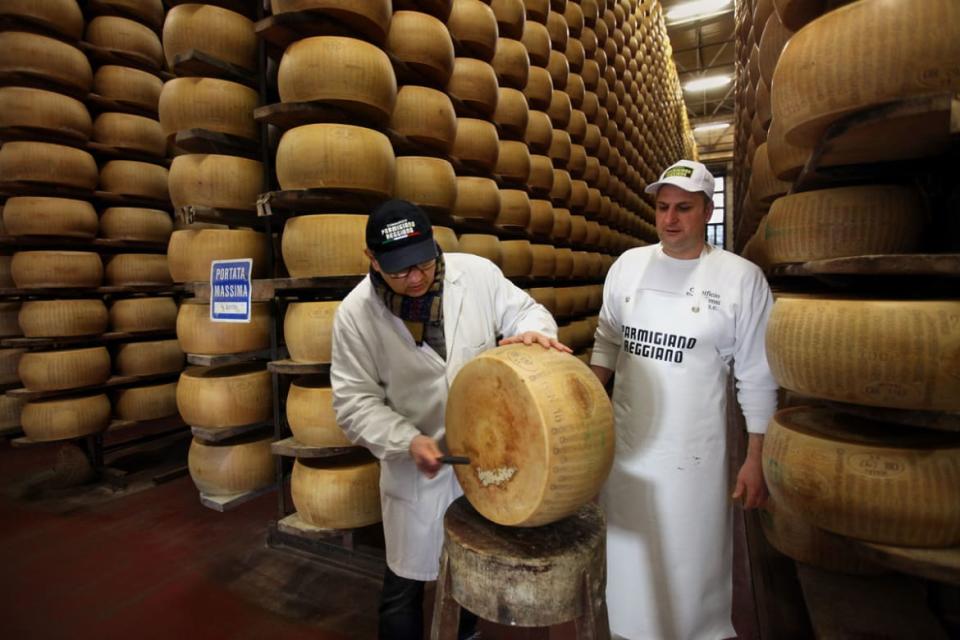
Parmigiano-Reggiano, the cheese must pass inspections and meet specific quality standards.
**
But there is another beloved claim-to-fame of this community that is neither made up of salt nor fat. His name is Giuseppe and he was born and lived in these parts a century ago. What’s ironic however is that I’ve heard that Giuseppe Verdi was not so fond of quaint Parma, and certainly not as much as he enjoyed nearby big city life in Milan, where he’d later trek in search of a career as a composer. It’s a career that wound up materializing into what became a famously-lengthy run of creativity and world-famous operas. Throughout an 87 year-run, he was the mastermind behind such classics as Rigoletto, Il Trovatore, Aida and La Traviata. Yes, along with the aforementioned dairy, Guseieppe is Parma’s favorite son, even though he did not return that sentiment.
Still, Verdi’s footprints are found all over Parma and its surrounding communities, with the late composer still conducting over this part of the world like a musical ghost. Sure, the composer Arturo Toscanini is also from these parts too, but his legacy is small potatoes compared to Mr. Verdi. (Also, Verdi never left Italy, while Toscanni decamped to New York for a time where he conducted in-house at NBC Radio).
While top-of-mind year-round, Verdi’s legacy truly takes center stage (or to tweak that figure of speech, steps squarely in the conductor’s stand) every autumn. That’s when Festival Verdi descends on the region; four weekends when the area welcomes a flood of visitors to feast their eyes and ears on his productions at Parma’s opulent Teatro Reggio as well as Teatro Magnani, located in nearby Fidenza, along with street performances and talks. Many of the Americans who attend are rabid fans of the opera and regularly traverse the world in search of the art form. The New York-based non-profit International Friends of Festival Verdi serves as the pipeline from America to Parma for many of the attendees, and it’s who I’ tagged along with during this particular weekend. Admittedly, for someone with a formerly-rudimentary knowledge of opera (I was happily stoned when I saw my first and only opera at New York’s Met, during which I was angrily hushed by the man next to me), it has been an education.
Luckily, Francesco Izzo is here to fill in my gaps. A part-time resident of Parma and a Professor of Music at the University of Southampton in England, Izzo is “Direttore Scientifico” of Festival Verdi Parma. In other words, he’s one of the keepers of Verdi’s legacy. Case in point, Izzo tells me with passion in his voice: “Verdi in Parma is a responsibility; not a right or privilege. It is a challenge and must remain a challenge.” Suffice to say, this is a man who takes his Verdi seriously.
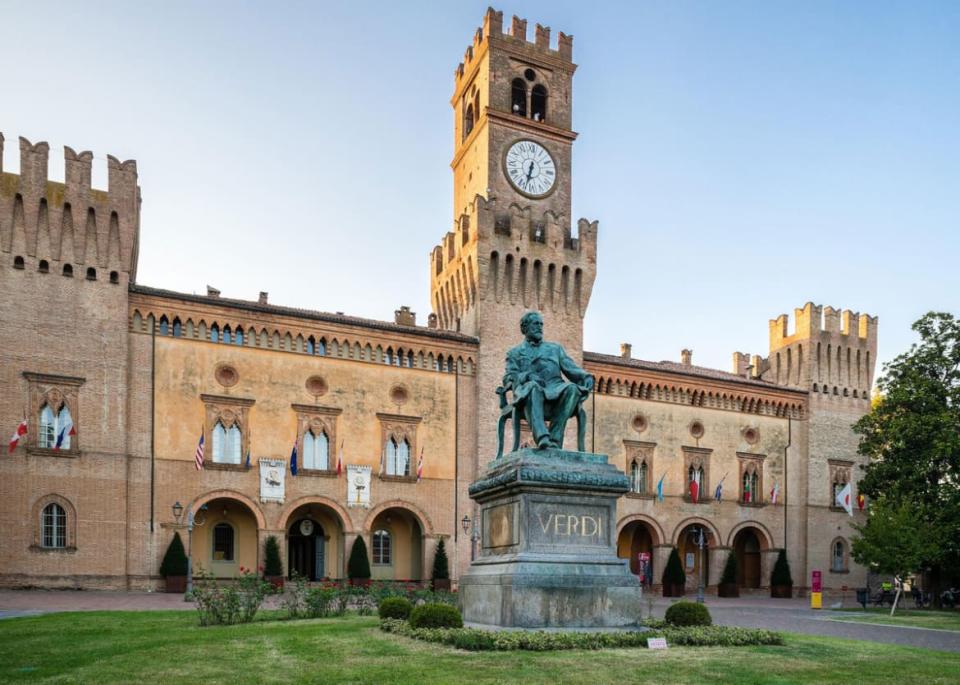
Verdi Monument in front of Rocca Pallavicino with Opera House Teatro in Busseto.
***
It’s Saturday afternoon in rural Roncole, located about 30 minutes from Parma proper. Still full from yesterday’s platefulls of, you guessed it, cheese and ham, and I’m walking through Casa Natale Verdi Museum, Verdi’s childhood home. Today, magnets of cheese wheels that say “Parma” are sold in the gift shop as an Italian flag waves outside in the country breeze.
It’s plain to see that Gusieppe decidedly did not come to age with a silver spoon in his mouth, but grew up in rather modest means here as the son of both an innkeeper and that long-ago full-time career known as a “spinner.” True to Italian form, there seems to be two dining rooms here: a small one and another that’s, well, bigger. A wooden table displays a place setting where the Verdi’s would have gathered around, complete with a bottle of Chianti and its distinctive wicker base, along with a loaf of bread. The floors here are lined with brick and the ceilings are outfitted with long wood beams, its imperfections distinctly convey a handmade quality.
Verdi spent his early years here which were marked by tragedy in the form of the death of his younger sister, Giuseppa, who was also his best friend. In fact, his later years were marked by a similar loss with the deaths of his only two children by blood, as well as his first wife; the latter of a brain inflammation with the terrifying name of Encephalitis. It’s no wonder why the operas I see during my trip are so angry with emotion, depicting extreme heartbreak and loss, with scenes ricocheting between pure jubilance and the depths of despair. While perhaps his most famous production, Il Trovatore, portrays characters exploding with an extreme joy, it ends with the two main lovers in a dungeon, both dying in utter agony.
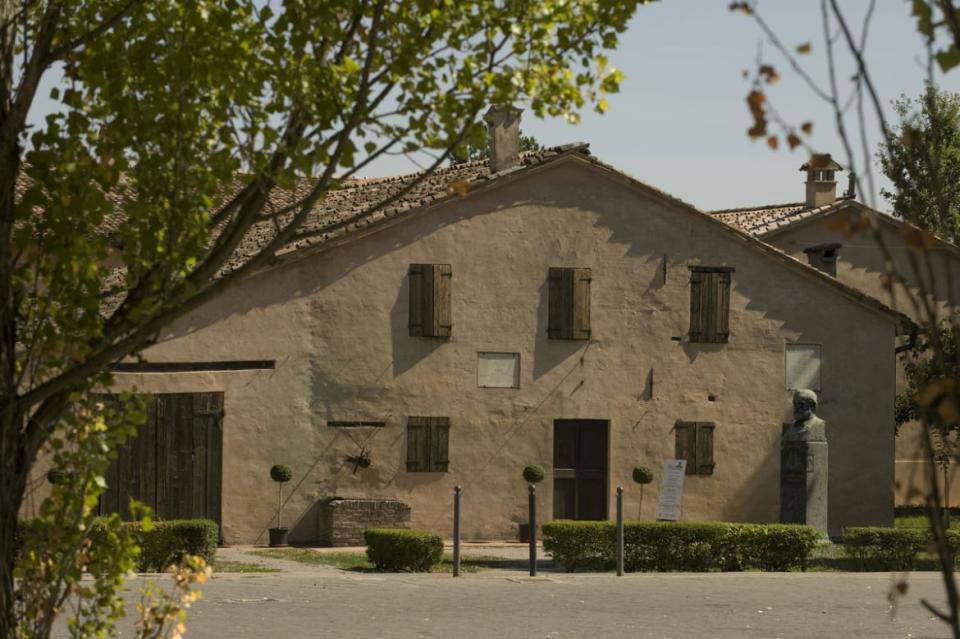
The house in the small village of Roncole Verdi (Busseto, Parma, Italy) where Giuseppe Verdi was born on October 10th, 1813, which is now a museum owned by the City of Busseto. August, 29, 2012.
**
The home Verdi wound up making for himself is much more expansive than his humble childhood digs. It’s called Villa Verdi, because when one is both famous and rich your home has a moniker that is equally as ostentatious as it is eponymous. Located in the village of Sant'Agata, the property has been virtually left untouched from his 1901 death, complete with his books, curtains and sheets, right down to his distinct black hat sitting idly by, unworn for the past 120 years. It’s a sprawling property complete with horse stable, wine room, and ornately decorated bedrooms complete with floral wallpaper which has long lost its bright color.
The man had a dedication to his craft which would be inspiring if it didn’t border on eccentricity, including sleeping in a separate bedroom from his wife in order, we’re told, to not wake her when late-night inspiration struck. Elsewhere, it’s been said that he purposely covered his walking path around the property with sand, because gravel would have drowned out his musical thoughts while on a stroll through nature.
After walking through his dusty bedrooms, I ask Izzo later about the basis of the festival itself. “In some ways, Festival Verdi has no reason to exist; it is utterly indispensable ” he says during a moment of candidness. Izzo is fully aware that we’re not talking about a ubiquitous household name like Beethoven or Shakespeare, but rather someone who the majority of lay people have never heard of. “The Festival can only exist when there’s still so much to learn about him, and there is, both in terms of performing his lesser-known works and also performing them in a way that’s closer to the spirit of the intention of Verdi himself.” For the team behind the festival, that also amounts to a sense of risk. Word to the wise: do not piss off opera diehards because they will retaliate. At a performance of Verdi’s Simon Boccanegera at the Teatro Reggio, some members of the (presumably vegan) audience booed at a new addition for the century-old show: the production's depiction of a butcher shop.
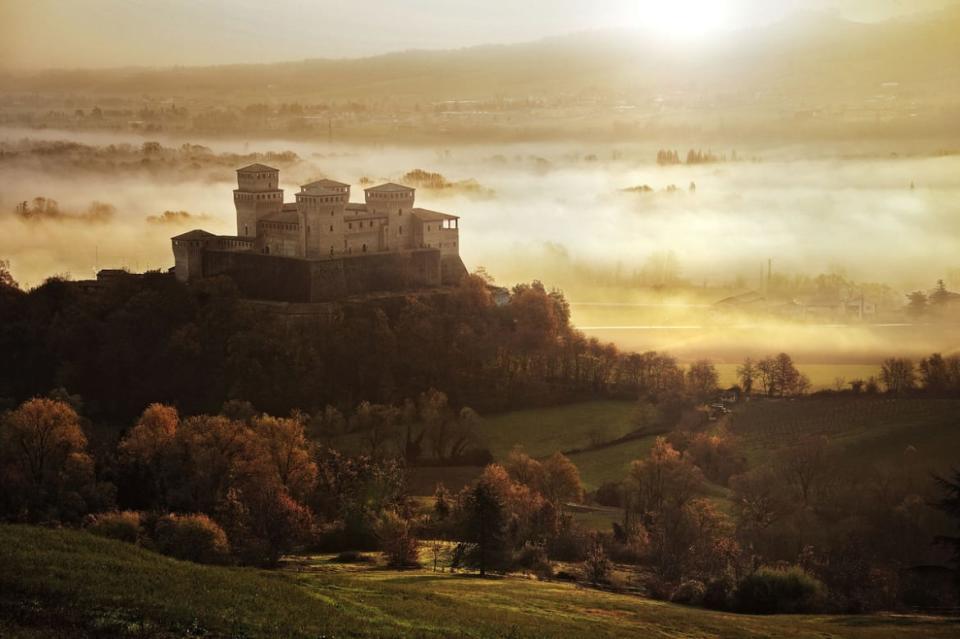
Castello di Torrechiara on hill at sunrise, Parma, Italy.
**
Back inside Villa Verdi, the tour guide breaks a bit of news that elicited gasps from the gathered group: after a century of private ownership, the home and property are closing to the public, perhaps for good, this fall. Filling me in on the backstory, Izzo explains Villa Verdi is for sale and only God knows if someone will buy it. Verdi’s distant family members don’t have the financial means to keep the place open. While Villa Verdi may revert to the Italian government, it’s an open question if they, too, would have the financial means for upkeep and public visitation. (It being the Italian government and all).
Then again, unlike in America, it’s not like they’re going to knock it down and build a Citibank. “According to Italian law, it needs to be preserved exactly the way Verdi left it,” Izzo explains. “So we hope they can find a motivated buyer who can step in, like an institute or university who may want to have cultural activities there.” Still, he adds with a wince: “For the moment, we’re at a stage where we don’t know what will happen. Which is scary. I prefer not to think about it.” A recent glimmer of hope came this past November when Gennaro Sangiuliano, Italy’s Minister of Culture walked through the house and assured the press there were “many entrepreneurs willing to intervene,” adding “the government is very attentive to the fate of this villa, of this museum, because Verdi is the foundation of our nation, he is a heritage of all Italians.”
Whatever happens to the Villa, I feel fortunate to perhaps be among the very last people in a legacy of multiple generations to see it. Regardless of what goes down, the Villa’s unsure future lends validity to both Parma and Festival Verdi’s obsession with keeping the man alive. It’s a mission that battles against the ending of memories, lives and real estate alike; even if Verdi himself wasn’t a fan of Parma as much as Parma currently loves him.
Izzo notably tells me that this Italian pride in Verdi came to fruition in the early 1900s. “There was a widespread quest for symbols of Italian role models and many cities began to celebrate and glorify and take pride in some of their most illustrious citizens,” he explains. “For Parma that’s Verdi. Every Italian city has a Verdi Street, Piazza Verdi, Ristorante Verdi, Pizzeria Verdi, and so on and so forth. But Parma does it to a much greater extent.”
“When my mother decided to relocate to Parma she moved to what was called the Verdi building,” he adds. “Verdi himself would have strongly objected to this.”
Get the Daily Beast's biggest scoops and scandals delivered right to your inbox. Sign up now.
Stay informed and gain unlimited access to the Daily Beast's unmatched reporting. Subscribe now.

